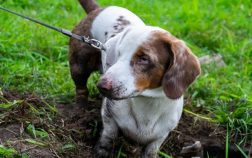Toy breeds’ small size is cute but also crucial for their health. So, here’s what we know about the toy dachshund full-grown height, weight, and more. For breeds like the toy wiener dog, this is especially important. This sub-type of the miniature dachshund isn’t even recognized by many major kennel clubs because they deem it too small to be a healthy breed.
So, how big can a toy wiener dog get exactly? And, what is the cut-off point between toy and miniature dachshund? Is the difference between the two really so detrimental to the toy dachshund’s health? We’ll answer those and more questions below.
What Exactly Is A Toy Dachshund?
Most kennel clubs around the world recognize only two types of dachshunds – standard and miniature ones. Standard dachshunds are about 8 to 9 inches tall (20 to 23 cm). Miniature dachshunds, on the other hand, grow only up to 5 or 6 inches (12 to 15 cm).
So, what is a toy dachshund? It’s a smaller miniature variant, bred to be as tiny as possible. While standard and miniature dachshunds are bred to be healthy and “functional” canine pets, for toy dachshunds, the priority is a bit different.
You can also encounter this dachshund sub-type with its two other names – teacup dachshund and kaninchen dachshund, kaninchen meaning “rabbit” in German. At the same time, because this sub-breed isn’t widely recognized by kennel clubs, some breeders try to further differentiate between toy, kaninchen, and teacup dachshunds. Such breeders claim that teacup and kaninchen too are different sub-breeds and are even smaller than the toy Doxie.

What’s The Typical Toy Dachshund Full-Grown Size?
An adult toy dachshund is always under 5 inches (12 cm) in height and under 8 to 11 pounds (3.6 to 5 kg) in weight. If it gets any bigger than that it should be recognized as a miniature dachshund and not a toy dog.
As for when is a toy dachshund full-grown, as with other dogs, toy adult size is usually reached between the 8th and 11th months. That being said, because these dogs are so small, it can be difficult to notice the exact time the growth stops unless you’re weighing your dog every day.
Toy Dachshund Full-Grown Weight Chart
| Toy Dachshund Age | Male Toy Dachs Weight | Female Toy Dachs Weight |
| 1 month | Less than 2.2 lbs (or 1 kg) | Less than 2 lbs (or 1 kg) |
| 2 months | Still less than 2.2 lbs (or 1 kg) | Still less than 2 lbs (or 1 kg) |
| 3 months | 2.2 lbs (1 kg) | 2.2 lbs (1 kg) |
| 5 months | 4.5 lbs (2 kg) | 3.3 to 4.4 lbs (1.5 to 2 kg) |
| 7 months | 6.5 lbs (3 kg) | 4.5 to 5.5 lbs (2 to 2.5 kg) |
| 9 months | 7 to 8 lbs (3.5 kg) | 6.5 to 7.5 lbs (3 to 3.5 kg) |
| 11 months | 8 to 11 lbs (4 to 5 kg) | 7.5 to 10 lbs (3.5 to 4.5 kg) |
Keep in mind that, because the breed isn’t standardized, these figures can vary. Many breeders try to breed even smaller dachshunds while others try to sell small miniature dachshunds and overpriced “toy dachshunds”.
Health Factors That Can Stem From The Small Toy Dachshund Full Grown Size
Like other toy breeds, kaninchen or toy wiener dogs can suffer from quite a few health problems that their larger siblings are less bothered by. These include:
- Heart defects
- Collapsing trachea
- Hypoglycemia
- Digestive problems
- Blindness
- Seizures
- Respiratory problems
- Physical trauma due to their small and fragile physique
And, like other dachshunds, toy wieners also have to worry about things such as:
Of course, these are all just risks – far from every toy dachshund suffers from these problems. If you get your puppy from a reputable breeder and with a health certificate – even if it’s a toy puppy – you can very well get a healthy puppy. From there on, it’s all a matter of quality food, careful but ample exercise, and routine vet visits. Do all that, and your toy pet can live as long as 12 to 16 years on average.
Why Do Many Kennel Clubs Not Recognize The Toy Or Kaninchen Dachshund?
The risk of health issues and irresponsible breeding practices are the main reasons why most kennel clubs don’t recognize toy breeds. This doesn’t mean that every breeder of toy dogs has such issues. However, it does mean that finding the right breeder can be tricky.
How To Weigh Your Toy Dachshund?
Weighing dogs is usually done by just weighing yourself first and then picking up the dog and weighing your combined weight. From there, it’s a matter of simple extraction of one number from another. This can certainly be done with toy dachshunds too, however, you need to be sure that your scale is properly calibrated.
Alternatively, if you have a precise kitchen scale, you can weigh the dog there. This should give you more accurate measurements, provided that you can get the dog to stand still for a hot second.
How To Keep Such A Small Dog Safe?
A big problem with tiny dogs is that they are incredibly fragile. This is especially true given that even standard dachshunds have back problems. A toy Doxie can literally break from a little fall or an accidental knock. And, since these dogs are so incredibly affectionate and always try to be near you and get your attention, you should have a very good spacious awareness with a toy wiener.
Pet-proofing your home is also strongly recommended. With toy breeds, this doesn’t mean putting rubber on the furniture’s edges but it means restricting your toy dog’s access to high places. Every place your dog can reach on its own should be a place it can’t fall from. Remember that dogs aren’t nearly as athletic as cats.
Is The Toy Dachshund A Good Idea For A Pet?
We certainly won’t tell you not to get such a dog. If this is the pet you want, there are many positives to these tiny bundles of joy. However, we’d recommend spending some extra time finding a healthy pup from the right breeder. From there, it’s all a matter of doing the research and prepping yourself to be the best possible toy dog owner you can be.





